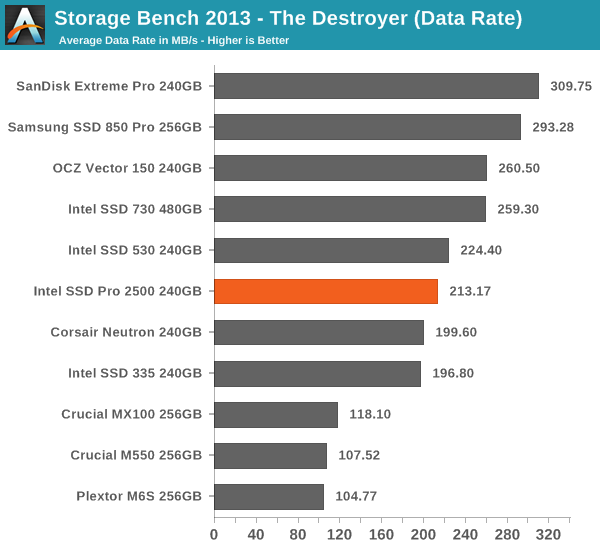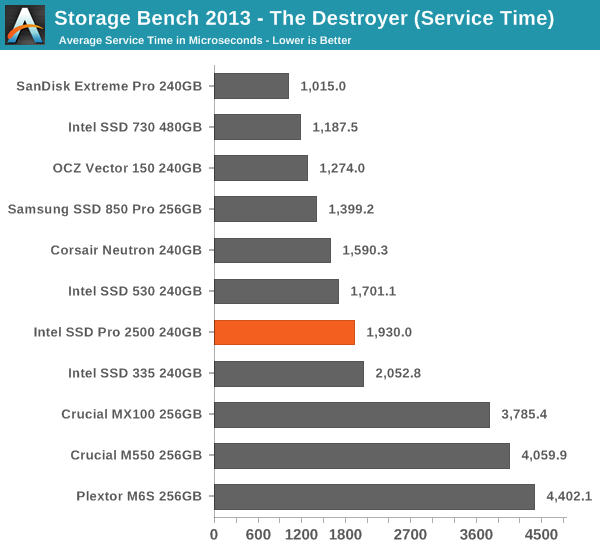Intel SSD Pro 2500 (240GB) Review
by Kristian Vättö on July 30, 2014 5:00 AM ESTAnandTech Storage Bench 2013
Our Storage Bench 2013 focuses on worst-case multitasking and IO consistency. Similar to our earlier Storage Benches, the test is still application trace based - we record all IO requests made to a test system and play them back on the drive we are testing and run statistical analysis on the drive's responses. There are 49.8 million IO operations in total with 1583.0GB of reads and 875.6GB of writes. I'm not including the full description of the test for better readability, so make sure to read our Storage Bench 2013 introduction for the full details.
| AnandTech Storage Bench 2013 - The Destroyer | ||
| Workload | Description | Applications Used |
| Photo Sync/Editing | Import images, edit, export | Adobe Photoshop CS6, Adobe Lightroom 4, Dropbox |
| Gaming | Download/install games, play games | Steam, Deus Ex, Skyrim, Starcraft 2, BioShock Infinite |
| Virtualization | Run/manage VM, use general apps inside VM | VirtualBox |
| General Productivity | Browse the web, manage local email, copy files, encrypt/decrypt files, backup system, download content, virus/malware scan | Chrome, IE10, Outlook, Windows 8, AxCrypt, uTorrent, AdAware |
| Video Playback | Copy and watch movies | Windows 8 |
| Application Development | Compile projects, check out code, download code samples | Visual Studio 2012 |
We are reporting two primary metrics with the Destroyer: average data rate in MB/s and average service time in microseconds. The former gives you an idea of the throughput of the drive during the time that it was running the test workload. This can be a very good indication of overall performance. What average data rate doesn't do a good job of is taking into account response time of very bursty (read: high queue depth) IO. By reporting average service time we heavily weigh latency for queued IOs. You'll note that this is a metric we have been reporting in our enterprise benchmarks for a while now. With the client tests maturing, the time was right for a little convergence.

The Pro 2500 ends up between the SSD 335 and SSD 530 in our 2013 Storage Bench. It is evident that the SF-2281 is showing its age and cannot compete with the latest high-end drives but for typical corporate workloads the performance is more than sufficient.











42 Comments
View All Comments
Impulses - Wednesday, July 30, 2014 - link
I don't think they ever intended to be a major player in the consumer side, low margins and all that, they jumped in to kickstart the market while other OEM couldn't get out of their own way.FunBunny2 - Wednesday, July 30, 2014 - link
Given that Enterprise SSD was the province of small vendors and RAM SSDs for more than a decade before NAND versions began to be built, Intel really has never had an Enterprise presence in SSD. That they make half-hearted attempts, using third-party controllers no less, means they won't be taken seriously. IBM could have bought their SSD shop, but took Texas Memory instead. There's a lesson in that.Kristian Vättö - Wednesday, July 30, 2014 - link
Saying that Intel has no enterprise SSD presence is just nuts. Last year Intel was the #1 enterprise SSD vendor in terms of revenue.http://regmedia.co.uk/2014/06/13/gartner_ww_ent_ss...
http://regmedia.co.uk/2014/06/13/gartner_ssa_revs_...
IBM's SSA revenue is not even close, let alone the fact that the array market is not the same thing as the enterprise SSD market. Many SSA vendors use drives from the enterprise SSD vendors.
FunBunny2 - Thursday, July 31, 2014 - link
Just because Intel/whoever shifts lots o SATA drek to ABC Corp. to fill up desktops and the occasional windoze/*nix document server doesn't make Intel/whoever an Enterprise Storage player.Enterprise Storage means:
fibre channel
serial attached SCSI
InfiniBand
"The first terabyte class FC SSD systems started shipping in February 2003."
Here: http://www.storagesearch.com/ssd-fc.html
You should spend some quality time with Zolt. You'll learn a lot about SSD.
kaix2 - Thursday, July 31, 2014 - link
what a funny bunny. intel focuses more on enterprise ssd and is the #1 vendor in that space. the 3rd part controllers are for low margin consumer drives.mikk - Wednesday, July 30, 2014 - link
Crucial and Samsung are much more interesting for client SSD users nowadays, Intel is more or less dead in this space.jeffrey - Wednesday, July 30, 2014 - link
Crucial more exciting than SanDisk in client SSD?? The value of the Extreme II and performance of the Extreme Pro are more interesting to me than anything Crucial has (price).hojnikb - Wednesday, July 30, 2014 - link
Have you looked at the Crucial prices recently ?They prety much destroy competition with price/GB.
emn13 - Wednesday, July 30, 2014 - link
Given the overall similarity of modern SSD performance in client workloads, price & reliability are the most important aspects (to me). It's not like even a fairly heavy workload will result in differences even a power user is likely to notice.mapesdhs - Wednesday, July 30, 2014 - link
Wow, are you really saying you'd opt for an MX100 instead of the Sandisk X210? Because
that would be a really weird decision (they're almost the same price here). The X210 is by
far the better product yet is only fractionally more.
Ian.